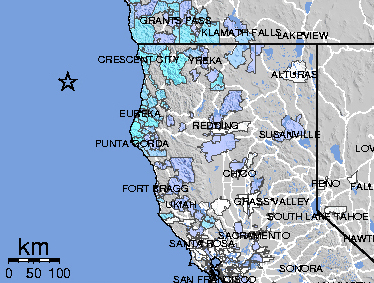Geotimes

Untitled Document

Web Extra
Wednesday, June 15, 2005
California earthquake spawns
tsunami worry
 Yesterday,
a magnitude-7.2 earthquake struck off northern California, triggering an hour-long
tsunami warning along the coast and prompting the evacuation of Crescent City,
a community that has had previous experience with devastating tsunami waves.
In the end, however, no major tsunami ensued.
Yesterday,
a magnitude-7.2 earthquake struck off northern California, triggering an hour-long
tsunami warning along the coast and prompting the evacuation of Crescent City,
a community that has had previous experience with devastating tsunami waves.
In the end, however, no major tsunami ensued.
The epicenter (shown here on this ShakeMap with a star)
of a magnitude-7.2 earthquake that occurred Tuesday evening local time set off
a tsunami warning for the entire West Coast, leading to an evacuation from Crescent
City, Calif. The aqua-colored areas indicate reports of light shaking on the
Mercalli intensity scale, and blue indicates weak-intensity shaking. Courtesy
of the U.S. Geological Survey.
The earthquake occurred Tuesday at 6:50 p.m. local time, about 145 kilometers
(90 miles) to the southwest of Crescent City, near the Mendocino Triple Junction.
The junction is a seismically active subduction zone, where a complex system
of faults interacts: As two small oceanic plates slide past each other, they
are also diving beneath the North American continent, while also interacting
with the Pacific plate. That means that the San Andreas Fault, as well as the
fault between the two plates, called the Gorda and Juan de Fuca plates, can
affect the region. But an earthquake on the subduction fault is most worrisome
because of its potential for creating tsunamis. Any vertical thrusting on such
a fault would push the water above, as it did with the Sumatra earthquake last
December.
Eric Geist of the U.S. Geological Survey (USGS) in Menlo Park, Calif., who
models tsunamis, says that seismologists pinpointed the earthquake's location
on the Gorda plate and magnitude within minutes. The problem, he says, is that
they "didn't know what kind of fault" it occurred on — subduction
or strike-slip — "until later." And the Gorda plate "isn't
really a plate," Geist says, but more of a tangled mess of oceanic crust
that has been severely faulted because of its position between the other plates.
Because of the uncertainty, the West Coast and Alaska Tsunami Warning Center
(operated by NOAA and the National Weather Service) issued a warning for the
entire West Coast from Vancouver to Southern California. After the tsunami warnings
went out, precautionary evacuations reportedly took place across California's
coast. Thousands of people were evacuated from Crescent City, according to the
Associated Press. The city had been torn apart by a large tsunami set off by
the 1964 Good Friday earthquake, a magnitude-9.2 event with an epicenter in
Prince William Sound, Alaska.
However, Tuesday's earthquake did not generate a large tsunami, despite that
fact that it was situated near a subduction zone and large enough to have done
so. Seismologists now think that the earthquake happened along a strike-slip
fault.
Still, in issuing the warning, "they absolutely made the right decision,"
Geist says. And a very small tsunami was generated, measured by NOAA's DART
buoys at about 1 centimeter in height, "not something that would be observed
by someone on the beach," he says, but still "quite visible"
in the data record.
"In essence this is an experience we can learn from," says Fred Turner
of the California Seismic Safety Commission, which will be reviewing the emergency
response to the earthquake and tsunami warning. "In hindsight, how did
the alert systems go, and what measures were taken at the local level along
the entire coast as a result of this? We're still in an information-gathering
mode."
Northern California and southern Oregon residents reported feeling light to
moderate shaking from the earthquake. No damage has been reported, according
to the USGS.
Naomi Lubick
Links:
USGS
Earthquake Hazards preliminary report
ShakeMap
NOAA
Tsunami Centers
San
Francisco Chronicle story
Los
Angeles Times story [needs password]
Back to top
Untitled Document

 Yesterday,
a magnitude-7.2 earthquake struck off northern California, triggering an hour-long
tsunami warning along the coast and prompting the evacuation of Crescent City,
a community that has had previous experience with devastating tsunami waves.
In the end, however, no major tsunami ensued.
Yesterday,
a magnitude-7.2 earthquake struck off northern California, triggering an hour-long
tsunami warning along the coast and prompting the evacuation of Crescent City,
a community that has had previous experience with devastating tsunami waves.
In the end, however, no major tsunami ensued.
